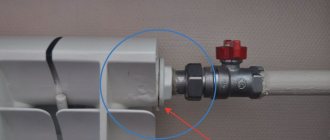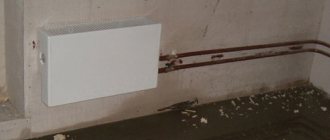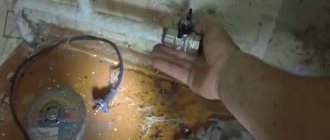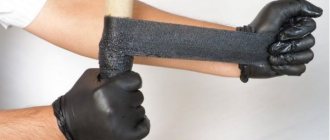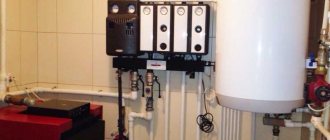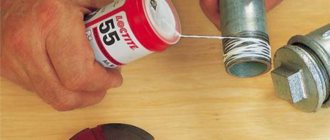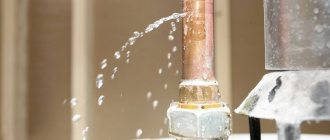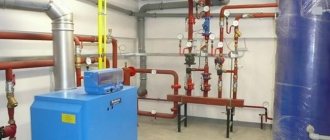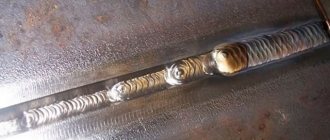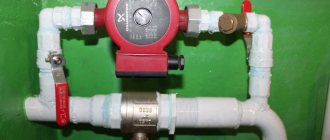A heating system leak is not uncommon, and in most cases it happens unexpectedly, except for test runs of equipment at the beginning of the heating season. It is not always possible to determine reliably what caused the leak, and this is not always important, since restoring the tightness of the heating circuit is in the foreground in such situations. As a rule, major repairs are postponed until the warm season, and when a leak is detected, they choose what to temporarily cover up the leak in the heating pipe.
How to seal a leak
In connection, on threads and joints
All heating elements are assembled into a single system using threaded, welded, soldered and fitting connections.
Any of them is the least reliable place and it happens - they leak. Leaks in pipe joints, whether metal or polypropylene, can be eliminated using epoxy resin-based glue. To do this, the surface of the metal pipe along with any damage must be cleaned of old paint and rust. You can clean it with a wire brush, sandpaper, or scrape it off with a knife. Prepare fiberglass or medical bandage. If the pipe has a diameter of 15 to 32 mm, the length of the fabric is approximately 30-35 cm. Then add a hardener to the glue base in the proportion specified in the instructions. You can add more hardener to increase the hardening speed. The main thing is not to overdo it, otherwise you won’t have time to finish before the glue hardens. Soak the fabric with glue and wrap the damaged area. Once hardened, the heating can be started. Work with rubber gloves. Leaks at the joints of polypropylene pipes can be eliminated in the same way.
Most often, threaded connections of the radiator and pipes leak. In these places and at the joints, in addition to epoxy glue, cold welding and cement-plaster dressings can be used. The method is old, but quite workable. Ready-made dressings are rarely found on sale. Therefore, they are prepared independently. Cement is mixed with alabaster (construction gypsum) in a ratio of 1 to 0.5, diluted with water to a thick rustic sour cream, the bandage is cut into strips of 30-35 cm, and placed in a container with cement-gypsum mortar, then soaked, applied in layers over the threaded connections, cover the top with the remaining solution. Sometimes salt is added to the composition.
In the radiator and pipes
There are damages in the radiator sections. It is often not possible to repair a hole in a radiator without dismantling it. It can only be sealed where there is access. If you are lucky and the hole is accessible, you can seal it using a roofing screw, bolt or chopper. Well, everything is clear with the chopper, sharpen it and hammer it into the hole, carefully cut off the excess.
If there is a large hole in the battery, you can install a bolt. To do this, you need to drill a hole and cut the thread using a tap and dip the body of the bolt in paint and screw it into place. This is easy to do only on paper, in reality everything is much more complicated. The same methods can be applied to pipe repair. If the pipe is thick-walled (3 mm or more)
Between battery sections
Leaks between battery sections can be eliminated if it is cast iron. For aluminum and bimetallic ones, the sections are located very close and it is impossible to get there.
Repair using cold welding or epoxy glue; in addition, a narrow clamp can be installed over the adhesive bandage or cold welding. It will press everything underneath it against the body of the battery. Heat-resistant sealant can also be used in combination with the clamp.
Hidden wiring
Hidden, this is part of the heating system, which is covered with a concrete floor screed, insulation or decorative boxes. In all these cases, the most difficult thing is to find and get to the place of damage. And after that, evaluate which repair method to choose. There is no way without professionals.
On a straight section
On straight and accessible sections, you can use any method that you like best and works better. But the most reliable method will be the mechanical method using clamps or bandages.
Required tools and materials
Depending on the method of repair, the set of tools and materials will change.
Let's try to unify:
- Set of welding equipment and electrodes. Welding repair.
- Box or open-end wrenches ranging in size from 8 to 24 mm. When installing bandages and clamps.
- Latex gloves.
- Pliers and knife.
- Annealed steel wire 1.5-2.2 mm.
Fixing a leak in a heating pipe without draining the water
What to do in this case if it is necessary to eliminate the leak? After all, in this case, cold welding will not help. There is a way out - this is the same “stub” discussed above. The material impregnated with the sealant is able to adhere even to a wet surface.
The mixture can be purchased at a hardware store. Wipe the surface of the pipe dry, and then wrap a cloth with sealant. This method of repair helps with minor digging.
If the leak in the pipe gets worse, use a piece of rubber as a temporary seal. For example, cut the required size from a bicycle or car tube. There should be a piece in reserve.
Wrap the prepared rubber tightly around the area where the crack is observed. For fixation, it is advisable to use one worm clamp or several pieces. You can use car clamps that are designed to connect pipes. Press down the rubber gasket with a clamp and screw it in with a screwdriver. This simple method will help eliminate the leak or reduce it slightly.
At the hardware store, you can purchase ready-made kits for repairing pipes in the event of a leak. It includes a prepared clamp with a rubber gasket and a small valve. Thanks to it, it is possible to drain accumulated water from under the clamp while installation is taking place.
After the clamp is securely fixed, the valve closes tightly and the flow stops. Such kits for repairing heating and other types of pipes help prevent an undesirable situation in the event of severe leakage. Other means are unlikely to save you.
In addition, if it is not possible to drain the water from the heating system, you can use another simple method. Using a special product, dry and freeze the section of pipe with the crack, and then seal it with glue or sealant.
The most relevant means are “Apparatus Moroz”, “FREEZE PACK” and others. Such treatments help to freeze the water in the damaged heating pipeline. At this moment, the water pressure in the damaged area decreases, which makes it possible to cut out a piece of pipe and weld a new one. You can also apply a “plug” to this area.
It is necessary to understand that the methods presented in our material for eliminating leaks in pipes using cold welding, sealant, adhesive, and ready-made repair kits are just a temporary measure. Over time, the crack will widen, rust may reappear and the leak will resume.
It is advisable to do a thorough repair of pipes in the summer, namely, drain the water and completely replace the area with a crack or rust. If this is not done, then in winter you can again expect unpleasant surprises. It is best to invite specialists for repair work.
The first signs of a pipeline leak
In most cases, leaks in utility lines are immediately noticeable. After all, puddles appear on the floor and other structural elements of the building. However, minor leaks are not always so obvious.
Heating pipe is leaking
If the leak is small, it can be determined by the following signs:
- PP pipes become wet;
- drops that look like dew appear in the area of the fittings;
- the pressure in the pipeline system drops sharply.
If any of the above situations occurs, the owner of an apartment or house needs to pay attention to the water supply network. Perhaps it's time for a renovation.
A leak that is not eliminated, even in the form of a small trickle of water, will cause irreparable harm. Moisture can get on electrical appliances, penetrate electrical cables, or ruin just-completed renovations for neighbors on lower floors.
The essence of the cold welding method
The idea proposed by the inventors of this method of connecting parts is quite simple. The composite material is thoroughly mixed, after which complex chemical reactions are launched, imparting new properties to the mixture. Over time, the soft composition hardens, penetrates the structure of the materials being bonded and becomes comparable in strength to metal surfaces.
Excellent performance characteristics make it possible to use cold welding to solve a wide range of household problems:
- Elimination of leaks in metal and polymer water-pressure structures.
- Sealing cracks in heating radiators.
- Sealing places of damage to metal elements of the car body.
- Strengthening problem areas of pipeline networks.
The material can become indispensable in situations where the problem section of the pipeline is in a hard-to-reach place, where, even if you wanted to, it would not be possible to use a welding machine or other bulky device.
Factors characterizing system depressurization
The heating system consists of the following main elements:
- heating boiler;
- pipeline;
- radiators;
- control and measuring and shut-off valves.
All of the listed elements are mounted in a heating circuit, the tightness of which depends on the integrity of the constituent elements and their connections.
The choice of method to restore the integrity of the heating system depends on the following factors:
- accessibility of the damage site;
- leak status (fistula, loss of tightness of a threaded connection, etc.);
- material of manufacture of the damaged element;
- availability of the ability to disable the system.
Based on the totality of the above circumstances, a method is selected to most effectively seal the leak in the heating pipe in the current situation.
Heating radiator leaking
If you find a leak in the heating battery itself, you can plug the hole using a simple self-tapping screw. This is done to reduce the flow of water, which will make it easier to carry out subsequent repair work, even if the taps are not turned off.
If a hole forms in the joint of the heating radiator, the problem is eliminated using a piece of fabric glued with epoxy. They wrap it around the damaged area. The leak has been fixed and you can rest easy until the end of the season.
By using a thick piece of fabric, electrical tape, tape and salt, you can also eliminate a leak in the heating battery:
- pour salt onto a cloth and wrap the damaged area;
- We secure everything with tape.
If the leak is not found, you should temporarily turn off the taps of the heating system, remove the battery, and lower it into a container of water. Then we determine the damaged area by the place where the air passes through. A sealant is used for repairs. After filling the damaged area, we additionally apply a fabric wrap and attach the heating radiators back.
Typically, at the top of the heating radiator there are air release valves that can be used during its operation. After the end of the operating season, the heating radiator or its damaged sections are replaced with new ones.
If a section of the radiator is leaking, the same procedure is followed as for a radiator leak.
Radiators and heating pipes can be either plastic or aluminum; they are a little more difficult to repair, and special skills are required to eliminate leaks in them. If a cast iron battery leaks, then cold welding will be required to repair it.
It is necessary to worry in advance about the availability of the necessary materials for repairing the heating system, and to repair everything more thoroughly after the end of the heating season.
Leaking hidden pipes
If the line is hidden in the wall or under the floor, then you should not rush to break the partitions to eliminate the leak. If the fistulas are still very small, perhaps you can save yourself from trouble with the help of ordinary mustard. But you just need its dry powder.
Literally 100 grams of the mixture must be poured into the expansion tank of the heating system. After just a couple of hours, all small holes will be closed. But the water in the main must be changed to fresh the very next day. Otherwise there is a risk of filter clogging.
You can use a special factory sealant. The principle of action is the same as that of mustard. Moreover, such a powder is suitable if antifreeze circulates in the system. But the water also needs to be changed within a day.
Preventing Leaks
In order to prevent the formation of leaks in sewer, plumbing and heating systems, you should follow the simple recommendations of specialists:
- do not allow the drain pipeline to become clogged;
- make sure that condensation does not form on the cold riser;
- freezing of the external pipeline is unacceptable;
Each of the proposed solutions to the problem does not cause technical difficulties. The only exception is a malfunction of the metal or plastic system on the drains. In this case, simply covering up the damaged area will not work; this will require the help of specialists and the use of equipment.
Causes of leaks
In non-pressure systems, emergency situations arise due to improper operation, poor-quality installation and manufacturing defects. A connection made incorrectly always causes network depressurization.
I drilled a polypropylene pipe into the wall, what should I do?
Polypropylene is not difficult to damage due to mechanical stress. Most often, leaks in a free-flow system occur precisely because of external interference. Mechanical stress negatively affects rubber sealing elements, which are used to make most connections in non-pressure networks.
In systems under pressure, accidents occur for the following reasons:
- physical impact;
- incorrect installation;
- non-compliance with recommendations during operation;
- increased blood pressure;
- erroneous assembly;
- use of low-quality materials.
Often, a violation of the tightness of the PP system occurs during repair and construction work. Often installers or builders drill into pipelines.
The cause of the emergency can also be factory defects, because there are polymer pipes made in China.
PP products have a durability of 50 years. This is exactly the guarantee that bona fide manufacturers of certified products issue.
Pipe connection is leaking
Leaks at pipe joints can be eliminated using the same homemade or factory-made clamps. If there is a difference in diameter, you can first wind the rubber band and then make or put on a clamp.
If the connection is threaded and drips from under the winding, you can pour alcohol onto the tow and then spread it with BF glue. It is alcohol soluble. Once on the alcohol-contained tow, it liquefies and can flow into the joint. Then, when the alcohol evaporates, the glue dries, and the “drops” stop. But this method only works if you have “drops” and not a “fountain”. And one more thing: such a processed connection is then very difficult to disassemble.
If it is possible to stop the system or disconnect the radiator (if there is a leak at the junction with it), it is better to repack the threaded connection. To do this, carefully and slowly unscrew the nut (lock nut). It needs to be turned away and then wrapped. Don’t make significant efforts - there is a high chance of breaking it, and then you will definitely have to stop the system and redo everything. After tightening the nut, remove all the tow or fum tape, remove any remaining sealant, and in general, thoroughly clean the threads. Wipe it until clean, you can treat it with a degreaser (acetone or pure gasoline).
If it leaks under the locknut, it can be repacked
Please note that there is no excess tow - just a little, and paste on top. Take the winding and paste (sealant), wind the flax and coat everything with paste
Now you can twist it. First with your hand, then with a key. But here you also need to work carefully: it’s very easy to break the thread. Therefore, hold the key not by the edge, but in the middle - it’s easier to calculate the effort. Don’t overdo it with the amount of tow either. If cast iron, in principle, does not matter how much winding you wind, then aluminum and bimetallic, as well as steel, can crack from a large amount. A microcrack first appears in the collector, into which water leaks. The metal corrodes, the paint swells, a section (or the entire radiator) is damaged
Take the winding and paste (sealant), wind the flax and coat everything with the paste. Now you can twist it. First with your hand, then with a key. But here you also need to work carefully: it’s very easy to break the thread. Therefore, hold the key not by the edge, but in the middle - it’s easier to calculate the effort. Don’t overdo it with the amount of tow either. If cast iron, in principle, does not matter how much winding you wind, then aluminum and bimetallic, as well as steel, can crack from a large amount. A microcrack first appears in the collector, into which water leaks. The metal corrodes, the paint swells, a section (or the entire radiator) is damaged.
But this is all in cases where the threaded connection is leaking. If a fitting under a press (metal-plastic pipes) has leaked, you can try to simply tighten it. In the case of copper pipes, only soldering will work. If there is a leak at the junction of polypropylene pipes, there is also only one option - cut out the damaged piece and weld a new one.
It doesn't matter what you use. The result is important
Where do leaks most often occur?
Basically, leakage occurs due to improper installation. The joints between pipes and radiators are considered especially weak.
But there is another big point - the wrong choice of material. There is no need to use polypropylene pipes intended only for cold tap water to install heating communications.
As a result, when hot water is supplied, they cannot withstand the resulting pressure, resulting in a leak.
What should you do to rid your heating system of this situation? When installing a heating system, it is recommended to use only reinforced polypropylene pipes. Most often, a leak can form at the joints at the place of the connecting seam or the connection of the pipe to the battery.
How to fix a pipe body leak
How to repair a leak in a pipe if there is a crack in the body? To resolve the problem, you can use one of the following methods:
- install the clamp;
- apply a bandage;
- use cold welding.
Installation of the clamp
The easiest way to eliminate a leak on the pipe body is to install a repair clamp. The special device consists of:
- metal case;
- rubber seal located inside the housing;
- fixing bolts.
Special device for eliminating pipe leaks
You can install the clamp yourself in the following way:
- the leak site is cleaned of dust and rust;
- the pipe is wrapped with a clamp;
- The device is fixed.
Eliminating leaks using a clamp
Applying a bandage
How to seal a leaking pipe if there is no clamp? To eliminate a leak, you can use a rubber, adhesive or cement bandage.
The rubber bandage is:
- piece of rubber. A cut from a bicycle inner tube or a medical tourniquet used to stop bleeding is ideal. Use a rubber cut to wrap around the cracked section of the pipe;
- small clamps, wire or other fastening straps for securing the rubber to the pipe.
Pipe bandage made from scrap materials
The adhesive bandage is installed according to the following scheme:
- the section of the pipe where the leak has occurred is cleaned of dirt using a solvent;
- fiberglass or medical bandage is impregnated with special glue;
Special composition for eliminating leaks
- the pipe is wrapped in prepared material in several layers;
Installing an adhesive bandage at the leak site
Watch the video to see how to cover a leaking pipe with epoxy resin.
A cement bandage is an analogue of an adhesive bandage. The bandage or fiberglass is impregnated with cement mortar prepared in a ratio of 1:10.
Cold pipe welding
A relatively new way to eliminate leaks is to use a so-called cold welding composition. How to coat a pipe to prevent it from leaking? For different types of pipes (metal, plastic, metal-plastic, and so on), different cold welding compositions are used.
Composition for various types of plastic pipes
Detailed instructions for using the mixture are given on the bottle with the active substance. Here is the general algorithm:
- Before applying the mixture, the damaged section of the pipeline is cleaned of dirt. If the composition needs to be applied to a metal pipe, then the crack is additionally cleaned of paint and rust;
Cleaning the pipe before cold welding
- A special composition is applied to the damaged area. If liquid cold welding in the form of glue is used, it is advisable to apply it with a brush. If a plasticine-like composition is used, then before application it is necessary to knead it thoroughly until a homogeneous mixture is obtained;
- the cold welding substance is evenly distributed throughout the entire area of the cracked pipeline, covering 3–4 cm more than the crack itself;
Coating the damaged area with a cold welding substance
- the composition is left until completely dry, which takes an average of 2.5 - 3 hours.
All methods given in the article for eliminating leaks on the pipe body, except for the use of cold welding, are only a temporary measure. To completely get rid of the problem, it is necessary to completely replace the damaged section of the pipeline. It is advisable to involve qualified specialists to perform this operation.
Features of surface preparation for applying adhesive composition
The use of an epoxy resin-based adhesive requires the fulfillment of a number of conditions regarding the preparation of the surface for gluing. First of all, it is the cleanliness of the surface. Cold welding fits perfectly on metal surfaces and, when it contains metal powder, forms a strong connection, which subsequently also forms a diffuse connection. But in order for the plastic mass to be evenly applied to the surface of the metal, it is necessary to prepare it.
When preparing you need:
- Remove traces of drips;
- Remove the paint layer down to the metal;
- Clean the metal with sandpaper;
- Degrease the surface to be coated.
There are no minor operations in the list of operations; all of them are important for proper gluing of surfaces. True, it is worth dwelling on degreasing in more detail. During mechanical processing, dust and other particles, such as paint residues, enter the battery repair point in the roughness of the metal. In order for the glue to adhere as closely as possible to the metal, the area is additionally degreased so that the surface is as clean as possible. This operation will avoid the formation of a fatty film on the metal, which, after the cold weld has dried, will form a cavity into which water will leak.
Constant hydraulic pressure and temperature fluctuations will quickly expand the area of the cavity, and the coolant will again begin to seep out.
How to fix a leak in a heating pipe
Methods for eliminating leaks in heating pipes depend on a number of factors:
- the material from which the pipe is made;
- location of the leak (flat area or junction).
The best way to fix a leak is to call a specialist who can fix all the problems. If this cannot be done for some reason, then there are other methods by which you can repair the pipe yourself.
Many have already dealt with the question of why a leak may form in a heating pipe. There are several ways to fix this common defect.
If the leak occurs on a flat section of the pipe, then you need to determine the location of the damage. Then place a piece of rubber larger than the hole on this place and tighten the entire structure with soft wire. There are ready-made materials for this procedure on sale.
If a leak appears at the junction of the heating pipe with the radiator or tap at the threaded connection, then in this case the task becomes somewhat more complicated. Pipes of different diameters can be located at the junction points.
You can also wrap a long piece of soft rubber around the leak and use a clamp to compress the damaged section of the pipe. This option is not the final way to eliminate the breakdown, since the connection point must be disassembled and, if necessary, remade. And this can only be done with the heating system turned off.
In a city apartment, you still need to call a specialist for this, but in a private house, with an autonomous system, you can do it yourself. Therefore, before the heating season, just in case, it is necessary to have spare parts or new couplings for connecting pipes.
If the cause of a leak in a heating pipe is a pressure difference in the coolant, then in this case it is necessary to eliminate this problem.
Due to the fact that the heating system uses pipes of different diameters, water hammer may occur, especially when the owner of an apartment or house tries to bleed air from the system. To eliminate this problem, it is necessary to create special expansion devices or compensation loops.
If a leak occurs between sections of the heating radiator, you can temporarily wrap this area with thick fabric, which is impregnated with sealant or moisture-resistant glue. When the glue dries, you can turn on the radiator. Then you should definitely invite a specialist to completely eliminate the leak.
You can use a special sealant for heating pipes “cold welding”. As the name suggests, this material has high drying strength. Therefore, this sealant is often used for repairs in heating systems and even in the repair of car radiators.
Sealant Cold welding
All methods for eliminating leaks in heating pipes are good. However, they are temporary. Only a specialist can completely eliminate all the causes.
When is it necessary to repair your heating system?
Naturally, major repairs of the entire heating system must be carried out in a timely manner before the onset of the cold season. If the heating pipe drips in winter, this means that appropriate measures were not taken in summer.
If the heating system was installed a long time ago and using steel pipes, then it’s time to think about replacing the metal elements of the system with reinforced polypropylene pipes. Recently, German REHAU plastic pipes, which are leaders in reliability and durability, have become popular. They are adapted to heating systems in our country and if installed correctly, heating pipes will not leak.
All plastic products are not subject to corrosion and have a high degree of strength. Therefore, replacing old worn-out metal pipes is necessary. Patching holes will not lead to a sufficient level of comfort, because every year more and more damage will occur.
It is much easier and cheaper to repair and replace heating systems and communications in the summer, when the heating system is turned off. All work must be carried out in a timely manner, otherwise in winter during severe frosts you will have to turn off the heating in the house.
Preparatory work
When spot repairing a heating system, it is first necessary to determine the specific location of the coolant leak. If the pipeline is laid hidden (in the wall, in the floor), lined with decorative elements or equipped with thermal insulation, the task becomes more complicated.
Important! In a situation where a pipe or joint embedded in a wall has leaked, it is advisable to consider the possibility of installing a new section of the pipeline, since it makes no sense to spoil the finish of the room to repair a pipe with a high degree of wear.
In the supposed emergency section of the circuit, decorative finishing and thermal insulation are dismantled, the location of the leak is found, after which the nature and extent of the damage, as well as its accessibility to repair, are assessed.
Spot repairs of the heating system can be of three types:
- mechanical - using crimping and tightening devices, electric welding and other means not based on the use of sealing solutions;
- chemical - using various types of sealing compounds that harden as a result of chemical reactions or drying;
- combined - sealing the circuit using a combination of mechanical and chemical methods.
If a mechanical repair method is chosen and the damage is not significant (needle fistula or drip leak), the heating system can be left in operating mode before starting work to eliminate the leak. If the damage is more serious, then the heating must be turned off:
- the autonomous boiler is turned off, the coolant is drained;
- in a central heating system, it is necessary to close the valve of the common riser and hang a warning sign on it, and then also drain the water from the system.
The technology for treating the base before sealing the circuit depends on the material of the pipeline, the status of the leak and the type of repair, but, in any case, the final result of the work is largely determined by the quality of surface preparation.
Leakage at joints
If the heating battery is leaking, what to do and how to fix this problem?
First you need to determine the cause, find out why the pipes are leaking.
Leaks in joints can occur for 2 reasons:
- loose connection of threaded connections;
- pipe body cracked.
Let's consider what to do in such a situation and how to seal leaks at the joints. To do this you will need the following materials:
- rubber tubes;
- wire;
- materials for similar welding - sealants;
- several fasteners, clamps;
- rubber bandage.
First, using a rubber bladder, we block the leak and fix it using 3 clamps or iron wire. We close the leak with one clamp, place the other 2 along the edges of the chamber, or use a plumbing bandage, which is also a thick piece of rubber attached to the pipe with a clamp. It is bolted together to provide a seal.
If a leak occurs at the junction of the pipe and the battery, tie a piece of rubber to the detected leak. We secure it with clamps directly at the leak site and on the pipe itself. A factory bandage or tube rubber can also be used here.
In such cases, cold welding can be used. It is performed using a sealant, which, after kneading, is applied to the damaged area, pressed firmly and smoothed. Hardening occurs within 3 hours.
Regularly, at least once a year, in the summer, it is worth calling a specialist to thoroughly inspect the entire system and replace parts in areas of possible leakage.
Repairing leaks mechanically
If you want to reliably repair the system and forget about the problem for a long time, you will have to spend money. Moreover, the list of means used is significantly expanded (the price of the product is indicated in brackets):
- clamp clamp for car cooling pipes (0.4 cu);
- pipe bandage with 4 bolts (0.7...10 cu depending on the material and workmanship);
- self-vulcanizing tape (2.5 cu);
- saddle clamp used for insertion, plus a plug (2...10 cu);
- reusable Kibosh clamp from the ROTHENBERGER brand for emergency leak repair (20 euros).
In addition to these devices, “original” fittings – couplings – are used to restore the tightness of plastic lines. The branch of the system is emptied, the pipe is cut at the point of leakage, then the ends are joined using a coupling.
Important point. If a metal-plastic breakthrough occurs inside the screed, a press connector must be installed (under the pliers); the compression coupling cannot be sealed in place.
Metal bandage (left) and plastic saddle clamp (right)
Another simple connector for steel is a reinforced hose of suitable diameter. The latter is installed instead of the cut out rotten section of the water supply system. Fastening method: tight or wire clamps.
Now we will explain one by one the technology of using mechanical sealing means:
- A car metal clamp is placed over a rubber seal (made from a bicycle or car inner tube). The option is cheap and durable, the disadvantages are its unattractive appearance and use only on metal pipes.
- The finished bandage is tightened with 4 bolts and placed on a metal and polypropylene line. It is much more reliable in operation and looks better, but is not applicable at joints and turns.
- The self-vulcanizing tape adheres to a cleaned and degreased surface, including flat surfaces. Suitable for sealing radiators and various pipelines, taps, connections. The disadvantage is that it is not available for open sale; the material is ordered through the online store.
- The saddle clamp is installed on a highway made of any material except metal-plastic. There is no need to shut off the apartment's riser or drain the coolant from the autonomous system. The element is compressed with bolts, and a plug is screwed into the outlet pipe.
- The reusable plastic clamp snaps onto the pipe by hand within 2 seconds. A very convenient device for eliminating accidents, but too expensive.
As you can see, only vulcanizing tape is suitable for all types of damage. The remaining clamps and bandages are mounted on straight sections of pipes; it will not be possible to seal the battery, joint or bend. But there are various chemicals for this purpose.
Options for repairing holes in a plastic pipeline
When carrying out repairs, it is not always possible to use high-temperature connection technology and therefore it is necessary to use other methods:
- Using a clamp clamp. A temporary measure to solve the problem of how to eliminate a leak in a polypropylene pipe is the use of clamps (for more details: “Types of repair clamps for pipes and rules for their use”). The part with screw clamps is supplemented with a layer of plastic waterproof material, thanks to which it is possible to almost completely eliminate leakage. This method does not interfere with the liquid moving through the system, so there is no need to turn off the water supply. But it also has a drawback - over time, the fastening points of the clamp weaken and the connection loses its tightness.
- Cold welding technology. Before repairing a leak in a plastic pipe, you should prepare the required amount of the component for the work: knead it in your hands or mix it in a certain proportion. Then the composition is applied to the damaged area, the crack in the pipeline is sealed and the required time is waited until the mixture completely hardens.
- Application of adhesive bandage. Using a pair of clamping clamps together with a material that is impregnated with glue will help you quickly deal with a leak with your own hands. This can be a two-component composition plus rubber for polypropylene pipe products or a bandage plus cement for sewer pipes. The advantage of this method is that there is no need to shut off the water flow. But for systems operating under high pressure, the use of such a bandage is not allowed.
- Sealing tape overlay. The method allows for quick repairs if it is not possible to seal a small leak with sealant. Several layers of adhesive tape are wrapped around the damaged area.
- Using a special sealant. It will be possible to eliminate a leak if a plastic pipe bursts quickly. But this solution is temporary.
There are three types of sealant on sale:
In cases where the water supply or heat supply system is partially laid using a hidden installation method, before proceeding with the repair of the plastic pipeline, you should find out exactly where the damage to the line occurred. To do this, unfortunately, you will have to either dismantle the decorative trim or open the wall covering.
Where to call if the heating battery is leaking
If a person lives in an apartment building and the battery begins to leak during the heating season, the responsibility for eliminating the malfunction lies with the management company. Such a case is considered an emergency.
First of all, the resident needs to prevent the possible consequences of a leak. In order to prevent damage to the floor covering or, even worse, to avoid flooding the neighbors below, you need to find dishes to place under the leak. After this, immediately call the management company. The repair team must fix the leak in the heating battery as soon as possible and inspect the entire system in the apartment.
You can find out the phone number of the management company from your neighbors by studying the information on the walls of the entrance, in receipts, in the contract for the provision of services (for example, intercom service) or in online directories (for example, reformagkh.ru).
How to fix a leak and solutions
How to repair a leak in a heating pipe depends on where it occurred: at the junction of sections, at the connection of the radiator with the pipe, on the pipe itself. Repairs are carried out in different ways, let's look at the main methods.
Heating pipe is leaking at the junction
Cold welding
As a rule, it is used at the junction of two battery sections and helps to temporarily close the damaged area. It is made using adhesive-sealant, which can be purchased at a hardware store. It has a special composition that crystallizes when it dries and fills the hole.
Applying “cold welding” to a metal pipe
Procedure
:
- thoroughly clean the damaged area from paint and rust using a brush with metal bristles or sandpaper;
- degrease, alcohol, solvent, acetone are suitable for this;
- cut off a piece of sealant, knead with wet hands until smooth;
- press well into the damaged area on the heating radiator and smooth it out;
- until the composition hardens completely, it must be pressed tightly to the surface;
- Curing time is approximately 20-25 minutes, complete polymerization is after 3 hours.
Cement-plaster cast
If a hole is found on the heating pipe or the junction of the battery sections, you can make a cement-plaster bandage; for this, prepare the following consumables:
- medical bandage, a piece of gauze or thin cotton fabric;
- alabaster (plaster);
- cement;
- bucket or basin with water.
Repairing a leak with a cement bandage
Procedure
:
- dilute cement in water, mixing it with gypsum, the consistency should be like that of rich sour cream;
- take strips of fabric or bandage 25-30 cm long, soak in the resulting composition;
- wrap a cloth around the damaged section of the pipe;
- overlays are made until the bandage is strong and tight.
Application of clamp and rubber
If you notice a heating pipe leaking, you can apply a commercial or homemade clamp, as well as a rubber lining, as a temporary measure. If there is a factory-made clamp of a suitable diameter, it must be applied to the leak and secured tightly with a bolt. If you don’t have one on your farm, you’ll have to make the rubber pad yourself.
Procedure
:
- cut a rectangle from a piece of rubber that will be 2-3 centimeters wider than the hole, the length should be the same as the diameter of the pipe;
- wrap the cover tightly around the pipe, and secure the edges with wire or metal clips; you can make a wire winding along the entire length of the bandage.
Repairing leaks with rubber and a clamp
Welding Application
If a heating battery (not metal-plastic, but cast iron) is leaking in a house or apartment, welding will help eliminate the defect. It can be used anywhere on the radiator. Therefore, after you have made minor repairs yourself or shut off the water supply to the battery, call the emergency service or a private company that provides hot welding services.
Repairing a metal heating pipe using welding
Prevention and care of radiators in summer
After the completion of the heating season, the pipeline must be tested (pressured) with increased hydraulic pressure. This is done in order to identify weak points and repair areas where ruptures or coolant leaks have occurred. The house main is subject to periodic internal flushing by utility services. Water is supplied to the system along with compressed air under pressure. A temporary break is made on the return line (unwinding of one of the connections) to drain dirty water through a hose or hose.
Dust and dirt accumulate on the outer surface of the batteries and on their ribs, which must be washed off in the summer with a cloth moistened with soapy water. Once warm, the cleaned surfaces can be coated with fresh paint. This will make them dry faster. Make the paint layer thin, otherwise it will crack later.
To avoid damage, do not use the equipment as supports or tie clotheslines to the risers. Read about warm floors on a wooden floor on our website.
How to fix a leak in a metal pipe
Below we will consider the simplest method for eliminating a crack that has formed in a metal pipeline. You don't need a plumber for this.
Remember that the appearance of cracks can be caused by ordinary human forgetfulness. For example, at a summer cottage, the water from the system was not drained before winter. The water in the pipes will freeze, causing them to burst in some places.
Let's move on directly to our actions, namely sealing the crack. What do we need for work?
- Small galvanized sheet metal.
- Cold welding, such as epoxy glue.
- Metal plate - clamp.
- Metal scissors, screwdriver.
- A vessel in which you will need to stir the composition.
Looking for a crack
Inspect the pipeline for cracks and make markings with a reserve. If the pipe is filled with water, drops or streaks will be visible. If it is hollow, then fill it with water to check.
Dry the crack area. Then clean off rusty deposits and layers of old paint.
Preparing a patch - a clamp
Measure the length of the crack and add a few centimeters to it on both sides. Cut the patch to the desired length from sheet metal. The clamp must be bent in your hands so that it takes an arched shape. Try it on so that it sits tightly on the pipeline.
Preparing the composition
We prepare cold welding for work - dilute it in a separate container if it is a little liquid. Or knead it with your hands if the composition has a dense consistency. You shouldn’t skimp on the adhesive mixture, but don’t overfill it too much.
Repairing the crack
Protect your hands with protective gloves. Apply the prepared cold welding compound to the marked crack that has formed on the metal pipeline.
Cover the leakage area with a piece of sheet metal. Bend the clamp as much as possible, attach it to the pipe and secure it with any ties. Wait a day for the cold weld to set firmly, then you can use the pipeline for its intended purpose.
On a note! After the cold weld has hardened, it is advisable to treat the area with fine sandpaper. The last stage is painting.
In the second option, you need to apply an arc-shaped piece of metal plate, liberally lubricated with glue, to the crack. Secure with zip ties. In appearance, such a repair may not look very aesthetically pleasing, but it is reliable.
Causes of fistulas
The reasons for the formation of fistulas on a water pipe most often come down to one denominator. This is the effect of corrosion.
The most suitable temperature indicator for corrosive formations is +15 degrees. Most often, pipe rolling materials are in this mode in the spring, summer and autumn periods.
Water located in the system also accelerates corrosive destruction. Over time, rust builds up inside metal pipelines.
The metal in such products becomes thinner every year. And then the moment comes when corrosion breaks through the wall completely. The result is a leak.
This problem must be eliminated immediately, without waiting until it turns into a big nuisance. If the leak is small, then it can be sealed under pressure without turning off the water supply.
The most common problems that result in a leaking heating pipe include:
- long operating time and severe corrosion;
- poor quality installation work, poor joints;
- loads of different types on the components of the heating system.
Since water is constantly under pressure in the pipe, and air temperature changes act on it from the outside, condensation can form, which leads to oxidation of the metal and accelerates corrosion processes.
Leaks can form not only in a metal pipeline, but also in a plastic one. Naturally, the problem most often arises as a result of mechanical damage or improper installation, since this material does not corrode.
The choice depends on the type of pipe
You can also simply fix the leak with epoxy glue. Plastic or fiberglass is selected as a bandage. The previously damaged area is thoroughly dried and cleaned. If the choice is fiberglass, then at least five turns around the pipe will be required. The width of the patch is measured according to the diameter of the pipe; it must be at least 1.5 units.
Glue must be applied to the bandage, which is subsequently pressed using clamps. Before starting the system, you need to wait a certain amount of time for the epoxy glue to dry thoroughly, that is, at least a day at a temperature of 15 degrees Celsius.
Repair of polypropylene pipes in hard-to-reach places
It is not always convenient to carry out repair work directly at the accident site. The difficulty lies in using a soldering iron, since the process is carried out in a limited space.
Plumbers work
In this case, to perform welding, perform the following steps:
- The tool is prepared and checked.
- Burrs, dust, dirt and grease are removed from the surfaces being welded. Degreasing is performed with wipes soaked in solvent or white spirit. The substance used must be completely dry.
- The soldering iron heats up to 260 °C.
- The hot pipe nozzle is removed using a gas wrench and quickly put on the pipe in a hard-to-reach place. At the same time, the fitting is heated on the soldering iron.
- The nozzle is removed from the pipeline element in a limited space, and the connecting part is removed from the tool.
- The heated PP parts of the pipeline system are joined.
The repair process in difficult places can also be carried out using a classic fitting with a union nut - an American one. It can be easily installed and removed. This fitting allows you to quickly remove the system assembly for repair or complete replacement. American provides a high level of tightness.
Manufacturers produce American fittings with internal, external threads and mixed types. They are made from various alloys, including steel and brass. American ones are produced in the form of plugs, crosses, tees and adapter couplings.

